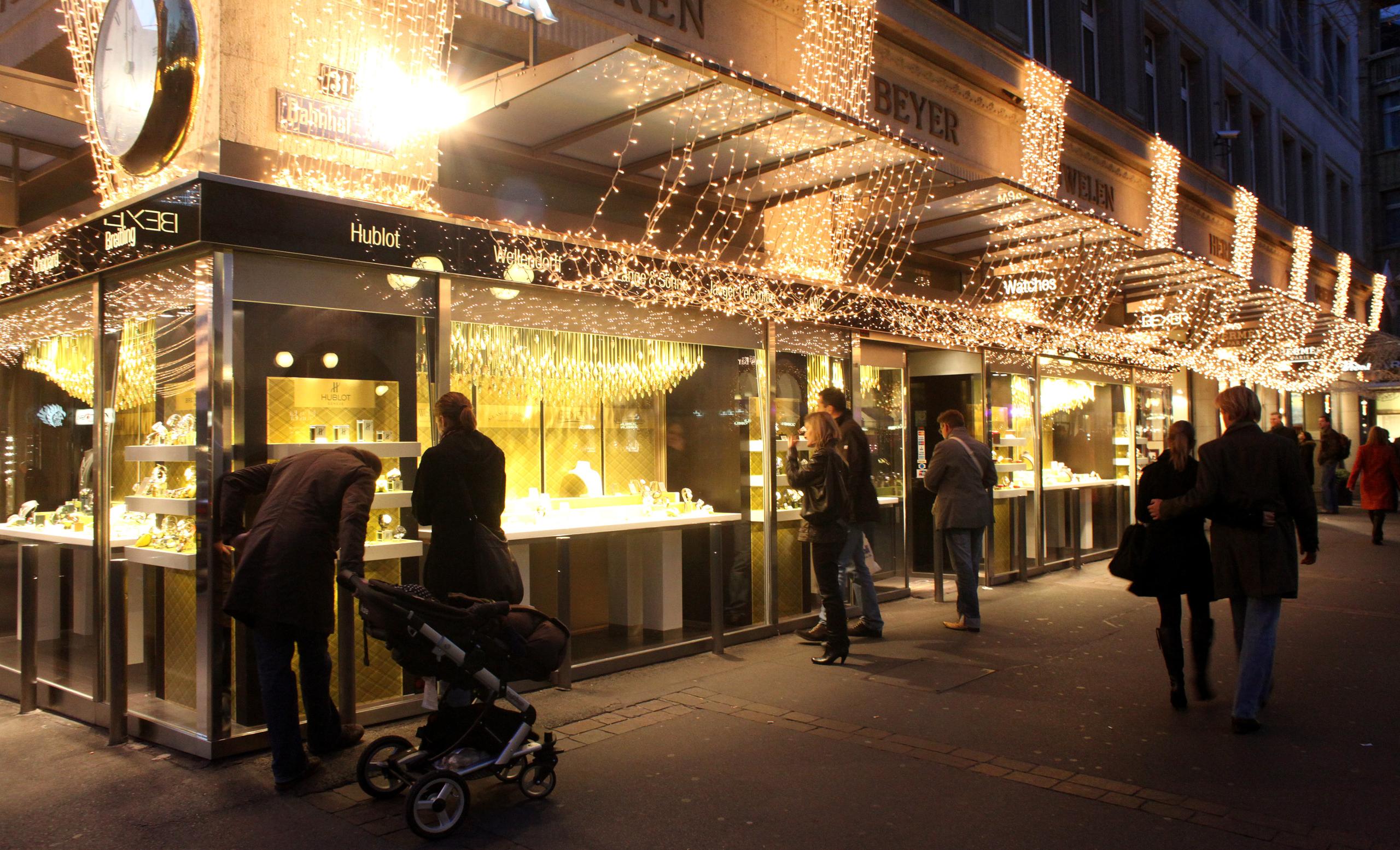
Bahnhofstrasse rues big brand influx on famous street

Flanked by big-name brands and watch shops, one of the few remaining family-run businesses on Switzerland’s famous Bahnhofstrasse shopping street is Brunos. The world behind its window display of classic hats and bow ties has become a rarity among what the street’s critics say is now a homogenous stretch of shops.
Between the heavily made-up women in fur coats and the tourists snapping pictures of Zurich’s twinkling Christmas lights, a step through a slim door with frosted panes of glass leaves the noisy street seemingly miles away.
“We used to have a lot of competition but many shops have disappeared, unfortunately. Our luck is perhaps in that we really specialise in high-end products,” Adriano Maestrini, deputy manager of Brunos, told swissinfo.ch.
As the likes of Burberry and Chanel have moved in close to this quirky purveyor of men’s clothing, it’s no small feat that the shop has managed to stay put at number 44 since Maestrini’s grandfather opened it in 1937.
In an annual assessment of the retail sector, property agents Cushman and Wakefield publish a list of the ten most expensive shopping streets worldwide in terms of average rental value. In 2014 Bahnhofstrasse came in ninth in the world, but had the smallest annual increase of 1.1%, putting the yearly price tag per square foot at $875 (CHF 846).
It pales in comparison with the cost of a square foot on New York’s Upper Fifth Avenue ($3,500 per square foot), but just five years ago, the average price on Bahnhofstrasse was CHF663.
The now 1.2km long Bahnhofstrasse was laid out nearly 150 years ago in 1865, and will mark its anniversary next year. The street connected Zurich’s lake shore to the main railway station.
The famous road’s most long-standing business, the confectionist and café Sprüngli, is in the rare position of owning its Bahnhofstrasse property, from which the company’s cakes and chocolate delicacies are sold.
But for most of the street’s proprietors, that’s not the case. The buildings are owned by banks, or in some cases individuals or families, and, as is the case for Brunos, insurance companies.
“We don’t know what the future brings, it might happen that they raise the rent so that we can’t pay it anymore. We’ve seen it with other shops,” said Maestrini.
With the average yearly cost of rent per square foot at CHF846, Brunos’ living-room-sized shop floor and a large area on the fourth floor made up of three connecting rooms, plus the cost of staff and the normal bills, it all starts to add up to a staggering sum of money for an independent retailer.
Prices in the shop range from CHF25 for a very small accessory to CHF50,000 for the one-of-a-kind, handmade luxury items. Brunos has to sell a certain number of tailored suits in order to pay the rent and still make a profit for themselves.
One of the most high-profile cases of this is the Zurich branch of Manor. One of the street’s four department stores, Manor is seen as one of the more affordable shopping destinations on Bahnhofstrasse.
Manor is located in the Oscar Weber building. The building’s owner, the insurance firm Swiss Life, wants to raise the rent, renovate, let the ground and first floor to multiple smaller shops and let the upper four floors as offices. It’s caused a dispute that is now in the courts.
In a written statement to swissinfo.ch, Manor described the process as “ongoing”.
Changing character
Set slightly back from the main street, overlooking a small square garden, the luxury department store Globus is decked out for the festive season. The store’s manager Daniel Künz heads up to his office on the top floor, taking flight after flight of escalators, through floors of themed gifts inside the building, which is owned by Globus’ parent company, Migros.
“We’re proud that the property that we’re in belongs to our parent [company]. As a consequence we definitely have an advantage,” he says, looking out over Zurich’s rooftops.
The combination of shops on the road and the impact that rising rental prices is having on them is a matter of concern, not just for shops like Manor and others who have already been priced out of their spot on the street, but even for those with a secure space.
“A mix of all brands, for all price ranges is very important, so that it’s attractive for all customers to come shopping here. It would be a real shame if it just became a luxury…or a too specialised street,” said Künz.
Independent boutiques
Domination by expensive big-name brands is either a problem or an opportunity, though, depending on the business owner you speak to.
At the boutique Little Black Dress, ten minutes’ walk away on Josefstrasse, a shopping street with more independent businesses, the Christmas party dresses hanging on the rack inside have been cut and made in Switzerland, and are produced in limited runs.
Designer and shop-owner Eliane Diethelm told swissinfo.ch that she and her business partner have spoken about and ruled out a move directly onto Bahnhofstrasse, but not to surrounding side streets.
“I don’t particularly like the shops there. You have the big chains with cheap manufacturing. You have to go to the upper side of the Bahnhofstrasse, where you have the more expensive brands, but then it’s also very quiet.”
Down the road from this small business is Urban Rider, an independent bike shop run by the Grafs, a husband and wife team.
Although Peter Graf says the design-focused neighbourhood of one-off shops fits their product, he laughs when asked whether a move to Bahnhofstrasse is something he would consider, if cost was not an issue.
“Of course! You have a lot more traffic there, a lot more people there who would be aware of your shop…but of course it’s also unaffordable.”
Diamonds and designers
“There are two sides to the coin. On one side it’s a result of the popularity of the street. On the other side, it’s not a good development if we just have jewels, watches and textiles. There shouldn’t be too many international brands,” said Markus Hünig, secretary of the 160-member Bahnhofstrasse Association.
The group mediates between the businesses and the local authorities, and looks after the street’s image.
“We try to discuss [this] with the real estate owners so that they still look for an interesting mix for the Bahnhofstrasse…but it’s a difficult job.”
A professional mediator and lawyer by trade, Hünig told swissinfo.ch that for the last five or six years, around one to three shops each year change hands to be taken over by international chains. The local names or Swiss-owned stores are fewer, and small, family-run shops are close to non-existent.
“If the owners are banks or insurance companies, they can be more understanding than private owners, but they still have to make a profit,” he said.
Overall, Hünig is optimistic that the street can keep a “local touch” in coming years, despite its popularity with global brands. Swiss businesses which are lucky enough to own their premises in some way, such as Sprüngli, he said, are key players in keeping that character alive.

In compliance with the JTI standards
More: SWI swissinfo.ch certified by the Journalism Trust Initiative































You can find an overview of ongoing debates with our journalists here . Please join us!
If you want to start a conversation about a topic raised in this article or want to report factual errors, email us at english@swissinfo.ch.